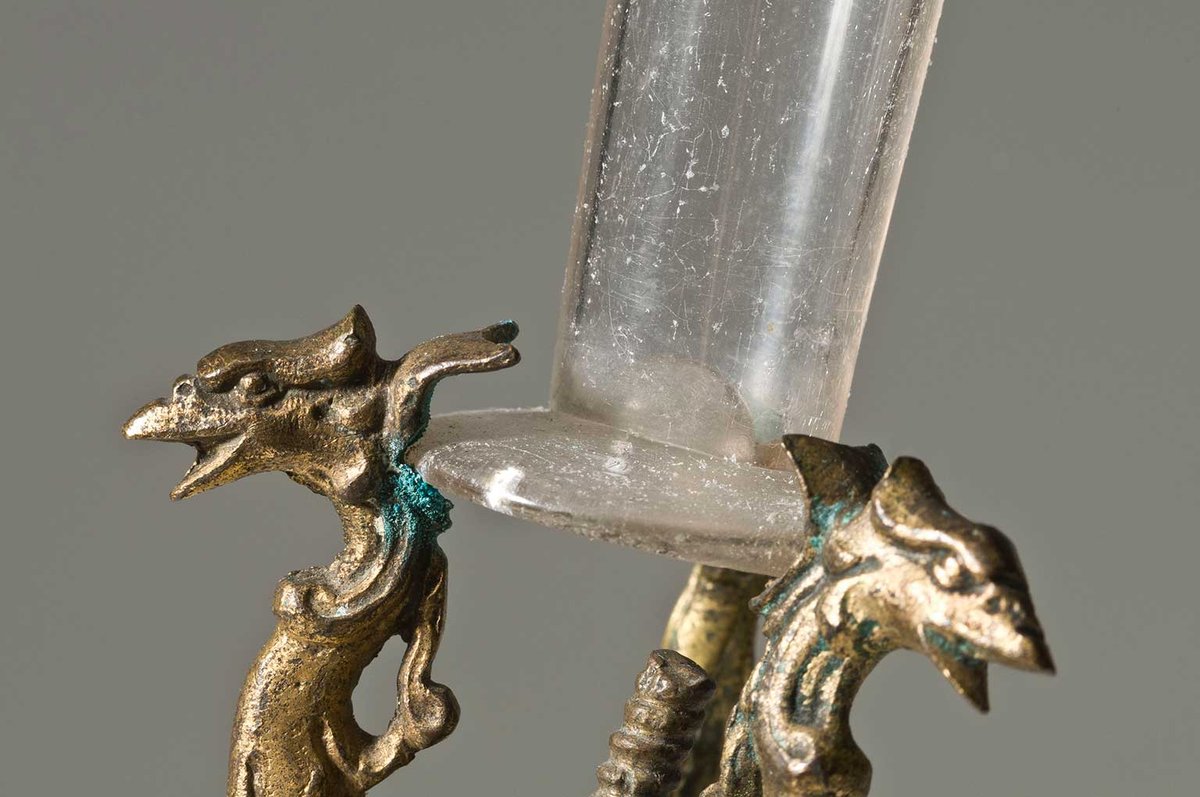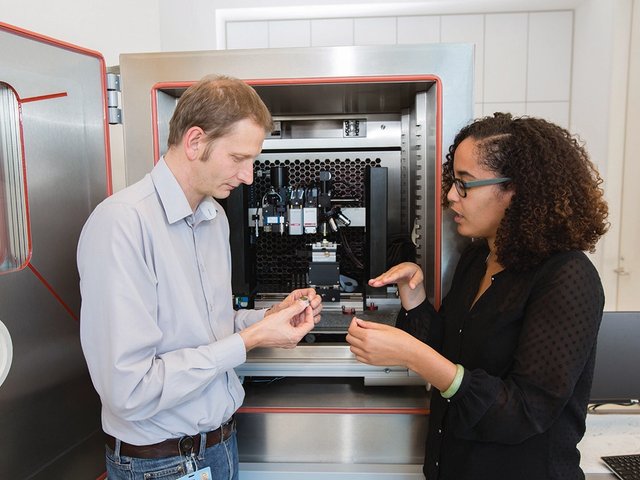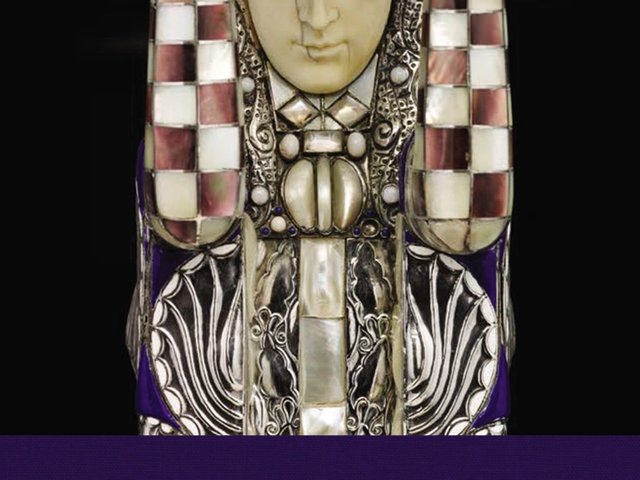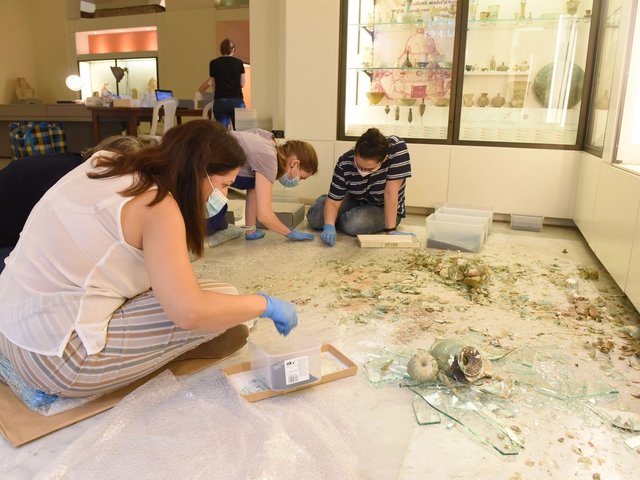The same powders used in making gingerbread or tofu, when mixed correctly, can protect treasures from harm.
Among the forested hills of northeastern Bavaria, conservator Heiner Grieb is looking over data on what has been unusual but everyday care for vitrines holding irreplaceable glass objects in Veste Coburg, an 800-year-old castle.
To keep humidity at good levels, Grieb and his colleagues place saturated solutions of water and magnesium chloride inside the cases: salts. They have been doing so for decades.
Now other institutions are taking an interest in Coburg’s uncommon conservation techniques. At a time when museums globally are under pressure to reduce their environmental footprints and cut costs, a cheap, effective conservation method is appealing. New research shows that salts may fit the bill, Grieb says.
“There’s low maintenance, a fail-safe system: no electricity needs,” he says. When Coburg introduced its salts in the 1990s, it kept the power off during the night for fire safety. It still does in parts of the museum. “Today, you can also say it is more climate-friendly,” Grieb adds.
Objects can swell and shrink in relationship to the changing humidity of surrounding air. Methods of setting ideal relative humidity today often rely on electric air conditioning or granulated silica gel: souped-up, larger versions of the sachets labeled “do not eat” that keep consumer parcels dry.
Salt solutions use a different chemical pathway but can achieve the same goal. They are cheap and, in some ways, easier to care for than silica and more sustainable than air conditioning. Their ability to absorb potentially damaging trace pollutants, such as formaldehyde and acetic acid, is a bonus.
‘It’s fine, it’s easy, it works’
A score of conservators and scientists recently examined the workings of salt solutions. These salts include potassium carbonate, which makes gingerbread flatten out; magnesium chloride, which can be used to bind tofu; and magnesium nitrate, which can be used for plant fertiliser.
Grieb worked alongside the now-retired Stuttgart-based conservation scientist and physical chemist Gerhard Eggert; Katja Siebel, a doctoral candidate and decorative arts and modern materials conservator in the north German town of Münster; and an analytics team led by Andreas Schütze from the University of Saarland. The federal German environmental foundation backed the project with a €125,000 grant.
It led to an exhibition in the Veste Coburg Art Collections and a multinational research survey among conservators at institutions including New York’s Metropolitan Museum of Art, Perth Museum in Scotland, the Getty, the Israel Museum in Jerusalem, and a score of German institutions. A detailed report is now published in German.
Silica is seen as easy and portable, a known entity that performs as advertised. Active air conditioning, including micro-units inside vitrines, can climatise at the flick of a switch. But micro-units are expensive, environmentally costly and dependent on a power source. And silica gel must be deliberately conditioned and periodically reconditioned, depending on the environment.
Even so, salt solutions are rarely used in conservation—even though the chemistry was well established before air conditioning and silica took over.
Eggert had heard about Coburg’s vitrines. What roused his curiosity was how the academic paper trail for salts as climate controller trailed off in the early 1990s. “You look at the articles, it’s fine, it’s easy, it works,” Eggert says. “Then in 1992 or so it all stops. Why?” Conservators may have worried about putting liquid in with precious objects, he says. Dried salts can accumulate up the sides of containers. And preconditioned silica—which was in the mix as early as the 1930s and recommended to curators in the 1950s—became more widely available.
In the late 1980s, Stanislav Ulitzka, an engineer and glass expert, surveyed Coburg’s glass collection. A looming threat was “sick” glass: historical glass can weep with humidity, leading to microcracks, degradation and corrosion in the metals that ornament or mount the glasswork.
Coburg curators chose to use salt solutions to ward off glass sickness. Modernisation during the 2000s brought in ten new redesigned wall vitrines. “The designs remedied technical deficiencies,” he says. “It was clear that we would stick with salt.”
Plucked out of oblivion
A museum vitrine is a singular environment featuring a profound object—a champagne flute once twirled at a wigged Venetian masquerade, or a hieroglyphed papyrus—surrounded by vapour and trace compounds. Time, age and chemistry shape the object, and can cause damage. Or an atmosphere can preserve it.
Schütze and his Saarland colleagues used complex sensors to measure what salt solutions can do for that preservationist environment. Eggert had already established that salts can absorb pollutants. The Saarlanders strengthened the case: salts soak up formaldehyde, acetic acid and formic acid. Siebel even devised the idea of using a rotten hard-boiled egg as a sulphur emitter in an experiment using salts to protect against silver tarnish (sulphur is a problem for both silver and copper in a closed space, absent some kind of absorber).
Karen Stamm, a conservator at the Met, likes the clarity of salts. “You know they will try to equilibrate to a specific value,” she says. Her colleague Julia Bakker Arkema, an associate research scientist, tested a saturated solution of potassium carbonate in an empty display as part of the survey.
There are caveats. Every object, every vitrine has specific elements that call for discretion. Right now, the Met does not use salt solutions for climate or pollutant control. Bakker Arkema says conservators have logistics concerns about integrating a liquid solution into an art enclosure. “How could we integrate a salt basin with a large surface area to casework with space limitations, or without a built-in silica drawer?” she says.
In a study, the conservation consultants Dennis Piechota and Jane Drake Piechota detailed techniques for using salts effectively, deploying membranes to guard against stray liquid and salt accumulation. They outline case studies, one with ancient Egyptian parchment and another with a case full of archaeological artifacts. The Piechotas say salts may until now have been a fringe technique, but deserve a second look.
Susann Böhm, a metals conservator at Friedenstein Palace in the German town of Gotha, has tested salt solutions in several cases. “We’re very satisfied,” she says. “Especially when it comes to absorbing pollutants. It’s hard to believe these methods have fallen into oblivion.”





